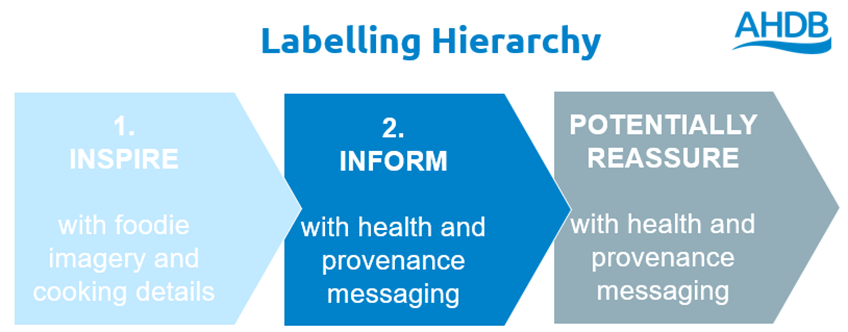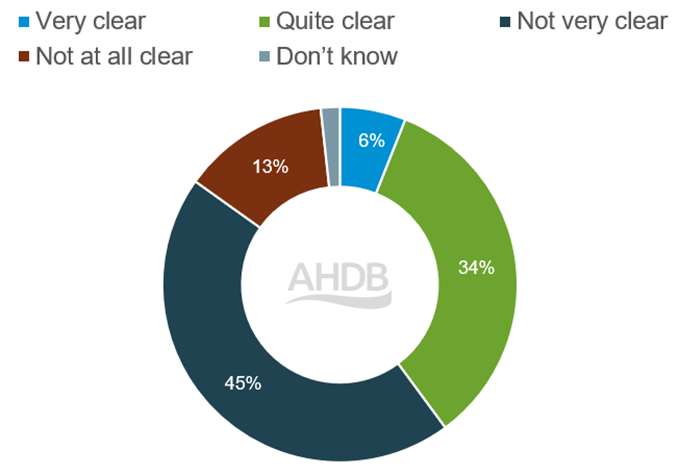- Home
- Hierarchy level 2 – Inform on provenance and assurance
Hierarchy level 2 – Inform on provenance and assurance
After shoppers have been tempted by the tasty food imagery, they like to be able to make an informed choice on the kind of meat they buy. There were two key pieces of information shoppers were looking for around health and provenance.

Animal provenance and welfare is not necessarily a driver of purchase; however issues can arise if this information is missing. Including it on pack boosts quality perceptions and the long-term view of the meat industry. Shoppers found is useful when the origin of the product was highlighted, and logos for assurance schemes were included. Information on animal housing and grazing were also seen as particularly beneficial for consumers.
In the first stage of the research, it came out as the top piece of information which shoppers wanted to see on pack.
There were a few nuances by cut, with farming practices more important for pork and farm specifics more important for lamb.
There were also a few slight variations in shopper types, with those who shop at discount stores finding farm location less important and premium store shoppers thinking the grazing practices were more important. Information on where the farm is is less important for shoppers who use discount retailers (e.g. Aldi, Lidl), while grazing practices are more important for shoppers who shop at more premium retailers (e.g. Waitrose, M&S).
Top 6 messages shoppers wanted on pack after the first stage of research

British messaging
When looking at the heat maps of appeal for the final label testing, British was one of the key appealing features to shoppers. If the product is of British origin, highlighting this is key. It appears to be the wording, more so than the flag, which is appealing to shoppers, however if there is space we would recommend including both.

One of the watchouts here is that British and provenance is a key feature which shoppers overclaim is important to them. From our shopper journey research, we see that it has less influence on shoppers at the point of purchase than they claim.
Grazing practices
In the final stage of the research, when ranking farming and environment messaging, again grazing practises came out as important with grass-fed and free range coming out top. This was closely followed by outdoor bred. For most consumers, this information satisfied their need to know where and how the animal was reared. Some consumers wanted even more detail, and having details of the exact farm was seen as a gold standard by shoppers.
Which of the below messages would encourage you to make a purchase? (of those interested in farming and sustainability messaging)
|
Comes from grass-fed and free range animals |
73% |
|
Comes from animals that are outdoor bred |
66% |
|
50% less packaging and fully recyclable |
62% |
|
Our farmers high standards maintain top animal health and welfare |
57% |
|
Eating locally sourced meat reduces your food miles |
55% |
|
Our animal welfare standards are world class |
54% |
|
World leading standards in animal health, welfare and food safety |
48% |
|
Red meat from the UK is amongst the most sustainable in the world |
41% |
|
Regeneratively farmed |
35% |
|
The carbon footprint of British pork has fallen by over a third since 2003 |
18% |
Environmental messages came lower down in the list of influential messages as shown above. Therefore, environment and sustainability are the optional final stage of the labelling hierarchy.
Assurance schemes
After seeing that animal welfare and assurance schemes were top after the first stage, it was important to get more detail from consumers in the second stage in the online community. During the deep dive into animal welfare and assurance schemes in our online community it was clear that they are a reassurance rather than a driver of purchase. When consumers were asked to design their ideal pack, most included assurance, however it was clear that for most shoppers, a simple logo was enough.

Red tractor scheme prominently displayed as reassuring. Shopper respondent


Key information and messaging can be represented by symbols, certifications and badges of the various welfare bodies. Shopper respondent

Our consumer tracker research with YouGov shows a good level of awareness particularly for Red Tractor and to a lesser extent RSPCA Assured.
Awareness of logos on meat

Source: AHDB/YouGov August 2023
Having the logo is reassurance enough for most shoppers and boosts the quality perceptions. Perceptions are likely to be improved with at least an awareness of the symbol. We tested some retailers own animal welfare or assurance logos and the ones shoppers were less familiar with were less well liked. Therefore, we believe these would be less meaningful for shoppers. While the red tractor is not necessary and it could be a different logo which is used on pack, it would be expensive to promote a logo to have the same level of awareness as the red tractor currently has.
However shoppers are not always sure exactly what the marks mean with over half of those aware of the logos not very or not at all clear with what they mean. This doesn't really seem to bother consumers.

This image [Red Tractor Logo] is helpful to the extent that I know it's supposed to tell me something positive about the farming process and the welfare of the animal. However I don't actually know what it means beyond that…. I wouldn't say it would be a deciding factor, but it might make me choose a product over a similarly priced product without the logo. Shopper respondent

How clear are you about what these assurance marks mean? (of those familiar with the logos)
Source: AHDB/YouGov, August 2023
Assurance and provenance summary:
- Clearly highlight if the product is British using both wording and visuals
- If possible include information on the origin of the meat and grazing practises
- Use assurance logos to reassure consumers – even if they don’t fully understand
- The gold standard with consumers would be information on the exact farm or location where the animal was reared


Sign up to receive the latest information from AHDB.
While AHDB seeks to ensure that the information contained on this webpage is accurate at the time of publication, no warranty is given in respect of the information and data provided. You are responsible for how you use the information. To the maximum extent permitted by law, AHDB accepts no liability for loss, damage or injury howsoever caused or suffered (including that caused by negligence) directly or indirectly in relation to the information or data provided in this publication.
All intellectual property rights in the information and data on this webpage belong to or are licensed by AHDB. You are authorised to use such information for your internal business purposes only and you must not provide this information to any other third parties, including further publication of the information, or for commercial gain in any way whatsoever without the prior written permission of AHDB for each third party disclosure, publication or commercial arrangement. For more information, please see our Terms of Use and Privacy Notice or contact the Director of Corporate Affairs at info@ahdb.org.uk © Agriculture and Horticulture Development Board. All rights reserved.


